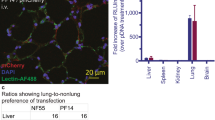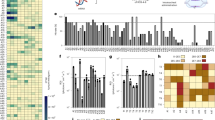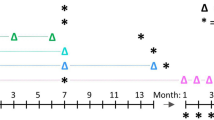Abstract
Airway inflammation frequently found in congenital and acquired lung diseases may interfere with gene delivery by direct administration through either instillation or aerosol. Systemic delivery by the intravenous administration represents an alternative route of delivery that might bypass this barrier. A nonviral approach for transfecting various airway-derived cell lines in vitro showed that cationic polymers (PEI 22K and 25K) and lipids (DOTAP, GL-67/DOPE) are able to transfect with high efficiency the reporter genes firefly luciferase and E. coli lacZ. Notably, two properties predicted that cationic vectors would be useful for a systemic gene delivery approach to the lung: (1) transfection was not inhibited or increased when cells were incubated with cationic lipids or polymers in the presence of serum; and (2) cationic vectors protected plasmid DNA from DNase degradation. A single injection of DNA complexed to the cationic polymer PEI 22K into the tail vein of adult mice efficiently transfected primarily the lungs and to a lesser extent, heart, spleen, kidney and liver. The other vectors mediated lower to undetectable levels of luciferase expression in the lungs, with DOTAP > GL67/DOPE > PEI 25K > DOTMA/DOPE. A double injection protocol with a 15-min interval between the two doses of DOTAP/DNA complexes was investigated and showed a relevant role of the first injection in transfecting the lungs. A two log increase in luciferase expression was obtained either when the two doses were comprised of luciferase plasmid or when an irrelevant plasmid was used in the first injection. The double injection of luciferase/PEI 22K complexes determined higher transgene levels than a single dose, but a clear difference using an irrelevant plasmid as first dose was not observed. Using lacZ as a reporter gene, it was shown that only cells in the alveolar region, including type II penumocytes, stained positively for the transgene product.
This is a preview of subscription content, access via your institution
Access options
Subscribe to this journal
Receive 12 print issues and online access
$259.00 per year
only $21.58 per issue
Buy this article
- Purchase on Springer Link
- Instant access to full article PDF
Prices may be subject to local taxes which are calculated during checkout






Similar content being viewed by others
References
Grubb B et al. Inefficient gene transfer by adenovirus vector to cystic fibrosis airway epithelia of mice and humans Nature 1994 371: 802–806
Korst RJ, Bewig B, Crystal RG . In vitro and in vivo transfer and expression of human surfactant SP-A- and SP-B-associated protein cDNAs mediated by replication-deficient, recombinant adenoviral vectors Hum Gene Ther 1995 6: 277–287
Epperly M et al. Prevention of late effects of irradiation lung damage by manganese superoxide dismutase gene therapy Gene Therapy 1998 5: 196–208
Ferkol T et al. Transfer of the human alpha1-antitrypsin gene into pulmonary macrophages in vivo Am J Respir Cell Mol Biol 1998 18: 591–601
Fasbender AJ, Zabner J, Welsh MJ . Optimization of cationic lipid-mediated gene transfer to airway epithelial Am J Physiol 1995 13: L45–L51
McLachlan G et al. Evaluation in vitro and in vivo of cationic liposome-expression construct complexes for cystic fibrosis gene therapy Gene Therapy 1995 2: 614–622
Biffi A et al. Restoration of bacterial killing activity of human respiratory cystic fibrosis cells through cationic vector-mediated CFTR gene transfer Hum Gene Ther 1999 10: 1923–1930
Stribling R et al. Aerosol gene delivery in vivo Proc Natl Acad Sci USA 1992 89: 11277–11281
Alton EWFW et al. Non-invasive liposome-mediated gene delivery can correct the ion transport defect in cystic fibrosis mutant mice Nat Genet 1993 5: 135–142
Hyde LJ et al. Correction of the ion transport defect in cystic fibrosis transgenic mice by gene therapy Nature 1993 362: 250–255
Eastman SJ et al. Optimization of formulations and conditions for the aerosol delivery of functional cationic lipid:DNA complexes Hum Gene Ther 1997 8: 313–322
Zhu N et al. Systemic gene expression after intravenous DNA delivery into adult mice Science 1993 261: 209–211
Liu Y et al. Cationic liposome-mediated intravenous gene delivery J Biol Chem 1995 270: 24864–24870
Thierry AR et al. Systemic gene therapy: biodistribution and long-term expression of a transgene in mice Proc Natl Acad Sci USA 1995 92: 9742–9746
Thierry AR et al. Characterization of liposome-mediated gene delivery: expression, stability and pharmacokinetics of plasmid DNA Gene Therapy 1997 4: 226–237
Li S, Huang L . In vivo gene transfer via intravenous administration of cationic lipid–protamine–DNA (LPD) complexes Gene Therapy 1997 4: 891–900
Liu Y et al. Factors influencing the efficiency of cationic liposome-mediated intravenous gene delivery Nat Biotechnol 1997 15: 167–173
Griesenbach U et al. Comparison between intratracheal and intravenous administration of liposome–DNA complexes for cystic fibrosis lung gene therapy Gene Therapy 1998 5: 181–188
Boussif O et al. A versatile vector for gene and oligonucleotide transfer into cells in culture and in vivo: polyethylenimine Proc Natl Acad Sci USA 1995 92: 7297–7301
Boussif O, Zanta MA, Behr J-P . Optimized galenics improve in vitro gene transfer with cationic molecules up to 1000-fold Gene Therapy 1996 3: 1074–1080
Boletta A et al. Nonviral gene delivery to the rat kidney with polyethylenimine Hum Gene Ther 1997 8: 1243–1251
Ferrari S et al. ExGen 500 is an efficient vector for gene delivery to lung epithelial cells in vitro and in vivo Gene Therapy 1997 4: 1100–1106
Goula D et al. Polyethylenimine-based intravenous delivery of transgenes to mouse lung Gene Therapy 1998 5: 1291–1295
Felgner PL et al. Lipofection: a highly efficient, lipid-mediated DNA-transfection procedure Proc Natl Acad Sci USA 1987 84: 7413–7417
Song YK et al. Characterization of cationic liposome-mediated gene transfer in vivo by intravenous administration Hum Gene Ther 1997 8: 1585–1594
Abdallah B et al. A powerful nonviral vector for in vivo gene transfer into the adult mammalian brain: polyethylenimine Hum Gene Ther 1996 7: 1947–1954
Dunlop DD et al. Nanoscopic structure of DNA condensed for gene delivery Nucleic Acids Res 1997 25: 3095–3101
Ogris M et al. The size of DNA/transferrin–PEI complexes is an important factor for gene expression in cultured cells Gene Therapy 1998 5: 1425–1433
Goula D et al. Size, diffusibility and transfection performance of linear PEI/DNA complexes in the mouse central nervous system Gene Therapy 1998 5: 712–717
Schwartz DA et al. CpG motifs in bacterial DNA cause inflammation in the lower respiratory tract J Clin Invest 1997 100: 68–73
Plank C et al. Activation of the complement system by synthetic DNA complexes: a potential barrier for intravenous gene delivery Hum Gene Ther 1996 7: 1437–1446
Bragonzi A et al. Glomerular filtration is required for transfection of proximal tubular cells in the rat kidney following injection of DNA complexes in to the renal artery (submitted, revised)
Lee ER et al. Detailed analysis of structures and formulations of cationic lipids for efficient gene transfer to the lung Hum Gene Ther 1996 7: 1701–1717
Song YK, Liu F, Liu D . Enhanced gene expression in mouse lung by prolonging the retention time of intravenously injected plasmid DNA Gene Therapy 1998 5: 1531–1537
Song YK, Liu D . Free liposomes enhance the transfection activity of DNA/lipid complexes in vivo by intravenous administration Biochim Biophys Acta 1998 1372: 141–150
McCray PB et al. Alveolar macrophages inhibit retrovirus-mediated gene transfer to airway epithelia Hum Gene Ther 1997 8: 1087–1093
McCray P, Wohlford-Lenane C, Snyder J . Localisation of cystic fibrosis transmembrane conductance regulator mRNA in human fetal lung tissue by in situ hybridization J Clin Invest 1992 90: 619–625
Sambrook J, Fritsch EF, Maniatis T . Molecular Cloning. A Laboratory Manual Cold Spring Harbor Laboratory Press: Cold Spring Harbor 1989
Behr J-P et al. Efficient gene transfer into mammalian primary endocrine cells with lipopolyamine-coated DNA Proc Natl Acad Sci USA 1989 86: 6982–6986
Alcorn JL et al. Primary cell culture of human type II pneumocytes: maintenance of a differentiated phenotype and transfection with recombinant adenoviruses Am J Respir Cell Mol Biol 1997 17: 672–682
Springer TA et al. Mac-1: a macrophage differentiation antigen identified by monoclonal antibody Eur J Immunol 1979 9: 301–306
Acknowledgements
This study was supported by a grant for Cystic Fibrosis from the Italian Ministero della Sanità (L 548/93) and the Associazione Lombarda Fibrosi Cistica. We would like to thank Dr D Gruenert for the 56FHT80- and CFNPE90- cell lines, Dr L Monaco for the pCLuc and pCMVβn plasmids, Dr J-P Behr for the DOGS cationic lipid, Dr J Alcorn for the anti-SP-A polyclonal antibody, and Dr I Simon for the anti-CD11b monoclonal antibody.
Author information
Authors and Affiliations
Rights and permissions
About this article
Cite this article
Bragonzi, A., Boletta, A., Biffi, A. et al. Comparison between cationic polymers and lipids in mediating systemic gene delivery to the lungs. Gene Ther 6, 1995–2004 (1999). https://doi.org/10.1038/sj.gt.3301039
Received:
Accepted:
Published:
Issue Date:
DOI: https://doi.org/10.1038/sj.gt.3301039
Keywords
This article is cited by
-
Cationic nanocarriers induce cell necrosis through impairment of Na+/K+-ATPase and cause subsequent inflammatory response
Cell Research (2015)
-
Optimizing the transient transfection process of HEK-293 suspension cells for protein production by nucleotide ratio monitoring
Cytotechnology (2014)
-
Transgene therapy for rat anti-Thy1.1 glomerulonephritis via mesangial cell vector with a polyethylenimine/decorin nanocomplex
Nanoscale Research Letters (2012)
-
Soluble TNF-α Receptor I Encoded on Plasmid Vector and Its Application in Experimental Gene Therapy of Radiation-Induced Lung Fibrosis
Archivum Immunologiae et Therapiae Experimentalis (2011)
-
WT1 gene silencing by aerosol delivery of PEI–RNAi complexes inhibits B16-F10 lung metastases growth
Cancer Gene Therapy (2009)



